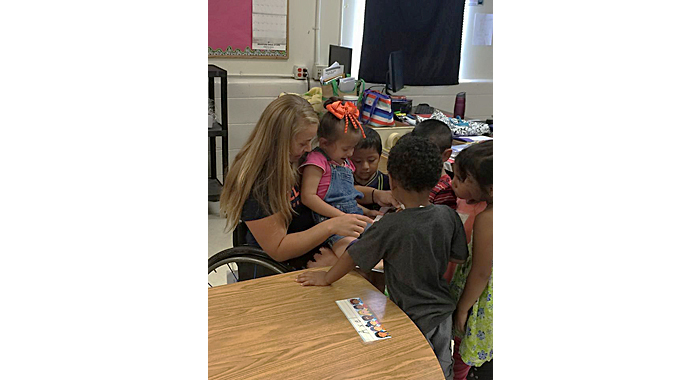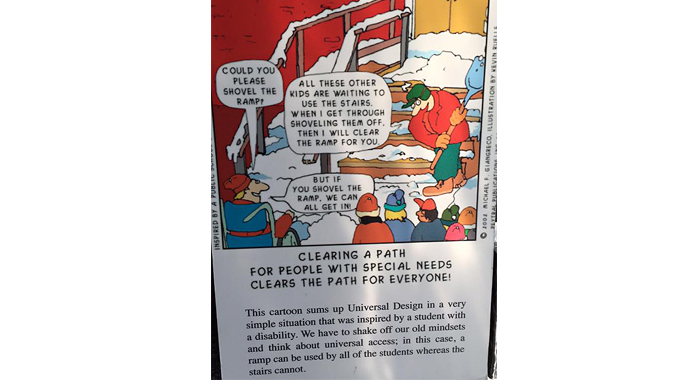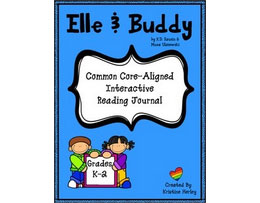
Teaching Students About Disability
The cartoon is from: America’s Disability Rights Museum on Wheels
One reason I love kids so much is because they see the world differently than most adults. Many children are optimists that live in the moment. they want to understand everything from the caterpillars metamorphosis to why they can’t eat dessert first. I’ve been watching videos of when my kids were little. Seeing their excitement while jumping off the couch or dancing to their favorite song brought me back to a time when I taught them about the wonders in the world and they taught me to see with fresh eyes. Those early years with my children inspired me to become a teacher.
During my first year of teaching our lives were turned upside down. My daughter was paralyzed in a car accident. I was lost. How could I teach my daughter about life using a wheelchair? I couldn’t. All I could do was teach her that the wheelchair was not going to stop her from living a full life. The wheelchair was not going to be an excuse that began with the words, I can’t because I’m….
And it worked. As I write this post, Arielle is attending a leadership workshop and scuba diving in the Cayman Islands with a group called Stay-Focused. Growing up Arielle saw obstacles as challenges to overcome. Her spirit grew stronger than her legs had ever been. Yet, even though Arielle saw herself as the same capable person it didn’t always mean others did. Time after time I witnessed people treating her differently. There was the Dr. that examined her for her yearly physical refusing to speak directly to her only to me. He spoke as if she wasn’t in the room. There was the man who wanted Arielle to get up from her theater seat and let him by. He pointed to her leg and rudely asked her to “move that leg.” There were all the taxi drivers that refused to give us rides. And there were daily questions from strangers like, “What happened to you?” and, “So if I shot you in the leg you wouldn’t feel it?”
I tried explaining to my daughter that people were ignorant. They didn’t mean to hurt her, they just didn’t know any better. But how long can that be an excuse? Recently, I saw an article in The Oprah Magazine’s Dear Lisa section where a woman asked if it was okay to park in a handicapped space because it was raining, and she was going to be quick. I wanted to scream! No, it’s never okay to park in a handicapped space if you don’t have a disability. Even if you are using a disabled placard knowing you can easily walk the extra hundred feet then understand you are risking the life of someone who doesn’t have the ability to stand and walk into the store like you do. Wheelchair users are low to the ground making it difficult for cars backing up to see them. It’s about safety, not convenience.
These were the conversations I had in my classroom when I taught. My third and fourth-grade students knew Arielle, knew what happened, and they had many questions. I answered them honestly and gave them an idea of what life was like for someone who was paralyzed. I believe they left with a better understanding of others. They witnessed how the wheelchair created certain obstacles for Arielle but didn’t change who she was. They saw Arielle and not the chair which I knew would help them do the same for other people they encountered in life who used wheelchairs.
ELLE & BUDDY Interactive Reading Journal
The reason I wrote MYSTIC, ELLE & BUDDY, and my new young adult novel UNFORGIVEN, was to give characters who use wheelchairs a voice. Yes, it’s so kids and young adults who use wheelchairs can have a character they hopefully can relate to, but also for the able-bodied. The more discussions we have in our schools about disability the better off we’ll all be.
I love author visits, but there are only so many I can do in a year. That’s why I was happy to see lessons have been created using ELLE & BUDDY in the classroom. ELLE & BUDDY is a fictional story that introduces kids to racing wheelchairs and disability. Teachers can lead a discussion on everything from why we have handicapped parking, ramps, and stores without cluttered aisles to the Paralympics and the history of racing wheelchairs. Most importantly teachers can show children that sitting down or standing up they are still the same person. We all our differently abled in so many ways.
“The highest result of education is tolerance.” Helen Keller






5 Comments
Jamie Ayres
What a great resource! Congrats on all your hard work paying off 🙂 I bet lots of kids will be touched by this resource during the next school year.
kdrausin
Thanks, Jamie. I’m hearing a lot of great things from teachers and parents. It’s exciting!
Kristine
This is a great post! You and your family are inspiring and fantastic role models.
kdrausin
Thanks, Kristine!
Pingback: